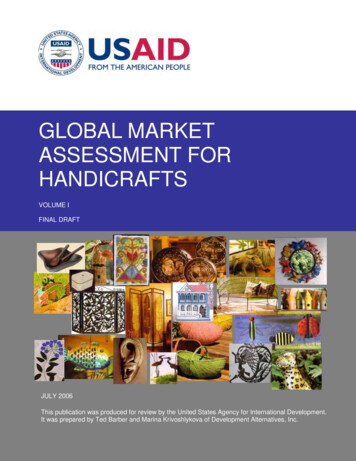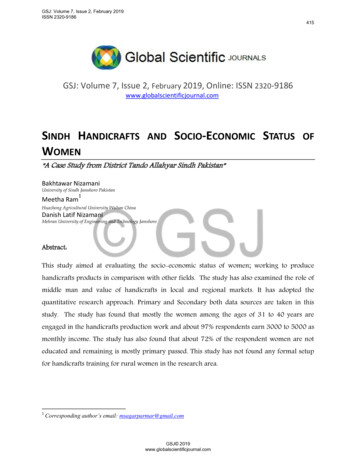
Transcription
GLOBAL MARKETASSESSMENT FORHANDICRAFTSVOLUME IFINAL DRAFTJULY 2006This publication was produced for review by the United States Agency for International Development.It was prepared by Ted Barber and Marina Krivoshlykova of Development Alternatives, Inc.
GLOBAL MARKETASSESSMENT FORHANDICRAFTSVOLUME IFINAL DRAFTThe authors’ views expressed in this publication do not necessarily reflect the views of the UnitedStates Agency for International Development or the United States Government.
FOREWORDThis paper was written as part of the Accelerated Microenterprise Advancement Project (AMAP)Business Development Services Knowledge and Practice (BDS K&P) research initiative. The AMAPBDS initiative’s major objective is “integrating micro and small enterprises into productive valuechains to create wealth in poor communities.”The research draws on experience and insights from: Interviews with leading handicraft buyers in the United States, the European Union, and theCaribbean, including importers and retailers currently sourcing from Haiti, those who have doneso in the past, and those who source handmade products from other destinations; Interviews with market experts, such as product development consultants, designers, enterprisedevelopment consultants, and marketing specialists who work with handicraft producers indeveloping countries; Discussions with market experts and USAID at a roundtable conducted in Washington, D.C., onApril 12, 2006; and Existing literature on the handicraft market and home accessory industry.This study provides an overview and analysis of the global market for handicrafts and the key trendsthat affect producers in developing countries, with the ultimate objective of offering practicalrecommendations for the Haitian handicraft sector. This paper represents Volume I of the GlobalMarket Assessment for Handicrafts study and includes Chapters I and II. Chapter I covers the globalmarket for handicrafts and key industry trends and Chapter II focuses on the end-market opportunitiesfor Haitian products. The document is accompanied by a video: Handmade in Haiti: The Perspectiveof Global Buyers, which presents an overview of the U.S. market for handicrafts and buyerperspectives on Haitian handicraft products.Volume II of this study (Chapters III–V), to be prepared jointly by DAI and ACDI/VOCA, focuses onthe supply-side constraints to Haitian handicrafts and offers recommendations for the development ofa competitive strategy.This paper benefited from the intellectual guidance of Jeanne Downing at USAID and was preparedunder the technical supervision of Lara Goldmark of DAI. Annex I lists the many experts and buyerskind enough to share their time with the authors. In addition, the following roundtable participantsdeserve special recognition: Emiliano Duch, Randy Eller, Karen Gibbs, Colleen Pendleton, GuillermoRicarte, and Alden Smith.FOREWORDIII
TABLE OF CONTENTSI. THE GLOBAL MARKET FOR HANDICRAFTS1DEFINITION AND ROLE OF HANDICRAFTS .1COMMONLY ACCEPTED DEFINITIONS .1Challenges Associated with Definitions and Data Collection.2THE GLOBAL MARKET FOR HANDICRAFTS.3Players and Channels.8Retailers.9Recent Changes and Nuances in How the Distribution Channels Work.13Price Segments .15Key Import Markets .17Key Export Markets .18TRENDS FOR THE UPCOMING DECADE .21Impact of Globalization.21Rapid Changes in Market Trends .21Towards Contemporary Minimalism .22The Push to Differentiate .23 Channels Keep Getting Get Shorter .26Growth in Online Sales .27Where to, Trade Shows? .27Heightened Awareness of Environmental and Social Concerns .28The Future Competitive Landscape is in Asia .29II. OPPORTUNITIES FOR HAITIAN HANDICRAFTS31HAITI AND THE MARKETPLACE .31Changes in the Landscape .32Purchasing .34Key Attributes .38HAITI: VIEW FROM THE MARKETPLACE .41Background .41Products.42Demand .47Buyers on Haiti.48Haitian Diaspora.53CONCLUSIONS.53BIBLIOGRAPHY57ANNEX 1: EXPERTS INTERVIEWED1-1LIST OF TABLES AND FIGURESV
LIST OF TABLES AND FIGURESTable1Home Accessory Market Segments.42Price Segments for Handmade Goods.15Figure1Handicraft Market Channels .82Dominant Handicraft Market Channels.33Images in Chapter I Country Originals, Inc., Spring/Summer 2006 catalog.Country Originals, Inc., Spring/Summer 2006 catalog.Julio Balan, Croix des Bouquets, Haiti, 2006. Photo by Ted Barber.Country Originals, Inc., Spring/Summer 2006 catalog.Country Originals, Inc., Spring/Summer 2006 catalog.Artisans of Haiti, Aid to Artisans, 2003. Photo by Chantal Regnault.Artisans of Haiti, Aid to Artisans, 2003. Photo by Chantal Regnault.FODAZE Gallery, Jacmel, Haiti, 2006. Photo by Ted Barber.FODAZE Gallery, Jacmel, Haiti, 2006. Photo by Ted Barber.Country Originals, Inc., Spring/Summer 2006 catalog.Artisans of Haiti, Aid to Artisans, 2003. Photo by Chantal Regnault.Country Originals, Inc., Spring/Summer 2006 catalog.Swahili Imports, www.swahili-imports.comCountry Originals, Inc., Spring/Summer 2006 catalog.FODAZE Gallery, Jacmel, Haiti, 2006. Photo by Ted Barber.Aid to Artisans, www.ata-haiti.orgArtisans of Haiti, Aid to Artisans, 2003. Photo by Chantal Regnault.Artisans of Haiti, Aid to Artisans, 2003. Photo by Chantal Regnault.Artisans of Haiti, Aid to Artisans, 2003. Photo by Chantal Regnault.Artisans of Haiti, Aid to Artisans, 2003. Photo by Chantal Regnault.Artisans of Haiti, Aid to Artisans, 2003. Photo by Chantal Regnault.Artisans of Haiti, Aid to Artisans, 2003. Photo by Chantal Regnault.Aid to Artisans, www.ata-haiti.orgArtisans of Haiti, Aid to Artisans, 2003. Photo by Chantal Regnault.Artisans of Haiti, Aid to Artisans, 2003. Photo by Chantal Regnault.Stephanie Armand, www.sudnco.com/globalframe.htmDwelling LLC, s of Haiti, Aid to Artisans, 2003. Photo by Chantal Regnault.Artisans of Haiti, Aid to Artisans, 2003. Photo by Chantal Regnault.Aid to Artisans, www.ata-haiti.org
EXECUTIVE SUMMARYHandicraft production is a major form of employment in many developing countries and often asignificant part of the export economy. With increased globalization, however, products are becomingmore and more commoditized, with artisan producers facing increased competition from producers allover the world, particularly in China and other Asian countries.The home accessory market, often used to estimate the demand for handcrafted goods, is stronglyinfluenced by fashion, consumer purchasing patterns, and economic conditions in end markets.Keeping up with frequently changing market trends presents a major challenge for handicraftexporters, and many observers fear that the advance of globalization has intensified this challenge andthe precarious nature of work and existence in artisan communities everywhere. However,globalization combined with growing markets for home accessories—especially in the United States,Canada, and Europe—also creates many new opportunities. In particular, the demand for “culturalgoods” is projected to grow with rising international tourism and an increasing focus on interiordecoration, and as a reaction (notably in upscale markets) to the homogenization of mass-producedproducts. Naturally, new opportunities bring new challenges: handicraft producers must be moreresponsive in adapting designs to buyer requirements, provide timely production and delivery, andimprove quality and efficiency in view of increased price competition and consumer expectations.This study provides an analysis of the global market for handicrafts and reveals the following trendsin the marketplace that impact handicraft producers in developing countries: There is a growing market for home accessory products, particularly in the high-endsegment. It is expected to grow not only in Western markets but in all regions as middle-classpopulations expand rapidly, particularly in China and India. This trend suggests that there arenumerous and expanding opportunities for artisans in developing countries to create products forthese markets. China and India—along with several other Asian countries—currently dominate handicraftproduction worldwide, and are likely to continue to do so for the foreseeable future. Theirposition is based largely on low-cost, high volume, Western-designed goods. Many buyers and consumers seek unique products made in countries other than China.While the market for purely indigenous designs is limited, “global style”—products that combineethnic elements with contemporary designs—is a growing category and represents an opportunityfor handicraft producers. Low-end (priority on low prices) and high-end (priority on high quality) markets areexpanding, while the middle (moderate quality at moderate prices) is relatively stagnant.Whereas competition at the low end is strong and requires significant production capacity, the“luxury” market tends to focus more on distinctive designs, higher quality, and smaller quantitieswith greater flexibility in pricing. Distribution channels in end markets are shortening. Large and, increasingly, mid-sizeretailers are importing directly, while small (and many of the mid-size) retailers continue topurchase merchandise principally, or entirely, from domestic wholesale importers. As this trendcontinues, many wholesale importers are losing important clients and many independent retailersare struggling to compete in a marketplace dominated by lower-priced “big-box” stores.However, there is evidence that savvy small retailers can compete with distinctive, high-endproducts. It is important to note that the vast majority of importers, both wholesale and retail, relyon the services of foreign exporters and agents, which many market experts see as critical to thesuccess of handicrafts in developing countries.EXECUTIVE SUMMARYVII
The large, direct-import retailers often operate in ways that present barriers to micro andsmall enterprises. Their purchase orders typically require high production capacities, strictdelivery dates, and specific labeling, packaging, and packing. Advance deposits are unusual,delayed payment terms are customary, and charge-back penalties for mistakes are common.While similar barriers exist with some wholesale importers, many order smaller quantities, offerprepayments to fund production with balances paid upon delivery, and have fewer requirementsthat could result in charge-backs. Buyers of all types prefer multiple product options to choose from, flexibility to makedesign modifications, and, above all, reliable partners. There are countless sources of productin the world vying for attention; what buyers seek most are items that sell from a producer whocan deliver. Home accessories and décor, gifts, and products for garden and outdoor living spaces are“hot,” with forecasted continued growth, as are products that are simultaneously decorativeand functional. These categories present extensive opportunities for handicraft producers.Drawing on findings from the marketplace analysis and using Haiti as the basis for the marketassessment, this study concludes that handicraft producers in developing countries should pursue thefollowing strategies in order to compete in the global marketplace:1. Focus on markets and channels in which there is less direct competition with high-volume, lowcost producers of “industrial” handicrafts, for example, the independent retailer market by way ofwholesale importers. Rather than competing directly with China, identify and sell to marketniches such as high-end home accessories and the importers whose smaller orders are declined bylarge craft factories.2. Develop more products that embrace the concept of global style in order to both access the largeand growing demand for contemporary design and remain distinctive in the marketplace.Opportunities for handicrafts exist in all market segments, but are most abundant for products thatfit comfortably into people’s homes and bring an authentic indigenous element into their lives.3. Look to local and regional markets for opportunities that may have been overlooked and canserve as a springboard to larger and more competitive markets.4. Constantly upgrade skills and techniques, including detailed handiwork, quality (especiallyfinishes), product development, and customer service to remain competitive, difficult to imitate,and appealing to work with. Investments to reliably deliver modest quantities of unique, highquality goods destined for higher-end retail stores are advised over those intended to improve theability to compete with low-cost, high-capacity producers.VIIIGLOBAL MARKET ASSESSMENT FOR HANDICRAFTS
I. THE GLOBAL MARKET FOR HANDICRAFTSDEFINITION AND ROLE OF HANDICRAFTSHandicrafts are unique expressions of a particular culture orcommunity through local craftsmanship and materials. Withincreased globalization, however, products are becomingmore and more commoditized and artisans find their productscompeting with goods from all over the world. It is no longerpossible to look at traditional artisan communities and theirproducts in isolation from global market trends andcompetition. Handicrafts are part of a much larger homeaccessory market, which includes handcrafted, semihandcrafted, and machine-made goods. The home accessorymarket is strongly influenced by fashion trends, consumerpurchasing patterns, and economic conditions in end markets.In many cases, artisans are out of touch with those endmarkets, which presents a challenge to those seeking toexport their products.The response of consumers to handicrafts is unpredictableand lends itself less to research and generalization than doesthe response to other products. “Consumers buy handicraftsbecause they like to feel connected with indigenous traditionsand cultures in a global and increasingly commoditizedworld.”1COMMONLY ACCEPTED DEFINITIONSHandicrafts are an important productive sector and exportcommodity for many developing countries (see Box 1.1). Thegrowth of international markets for home accessory productsand an increased interest in global goods have opened up newmarket opportunities for artisans. Despite widespreadproduction, however, there is a lack of common definition ofhandicrafts, although various attempts have been made tocharacterize this broad and rather unstructured sector.2 Themost common themes in the definitional debate center onhow the product is made, especially the importance ofhandmade vs. machine-made production;3 the significance ofBox 1.1: Role of Handicrafts inDeveloping EconomiesToday, in many developing nations,handicraft production is a major form ofemployment and in some countriesconstitutes a significant part of the exporteconomy. Observers of the handicraftssector predict that the escalating number ofsmall businesses turning to handicraftproduction is unlikely to decline significantlyin the future.* More specifically, artisans havebeen identified as the second largest sectorof rural employment after agriculture in manyregions of the world.**Handicraft production crosses all sectors ofthe modern global economy—from preindustrial to industrial and post-industrial.Artisan production has thrived becausehandcrafted products offer distinctadvantages: minimal start-up capital, flexiblework hours, the ability to work at home, andfreedom to manage one’s own business.Unlike many other forms of labor, artisanproduction can also enable a degree of laborautonomy for those who have limited accessto the cash economy.† As a means oflivelihood, handicrafts provide an idealavenue for creative, independententrepreneurs.†† An addition, they offeropportunities for seasonal employment andsmall production runs, and the sector is oftena default occupation for producers who havelimited other options for employment.Sources:*Herald (1992) cited in Seung-Eun and Littrell,2003, p. 357.**Basu (1995) cited in Seung-Eun and Littrell,2003, p. 357.†Scrase, 2002, p. 1.††Morris and Turok, 1996, p. 4.1Interview with Mimi Robinson.2Mikkelsen and Hagen-Wood (1998) explain how attempts to define the handicrafts sector are made difficult by its broadand amorphous nature. Handicrafts cover the use of a vast number of different materials, skills, tools, and techniques, andmay include a wide range of products, from individual objets d’art of unique cultural and ethnic significance to functionaland decorative wares produced on a semi-industrialized basis.3Some literature argues that handicrafts translate into part of a culture and industry that applies local raw materials andhand tools to produce items that portray an artisan’s talent in a way different from machine-made or mass-producedcounterparts. (ICCIM, 2000.)I. THE GLOBAL MARKET FOR HANDICRAFTS1
artistic qualities of the product vs. simple crafts;4 and the motivation for production, which may berooted in culture and tradition or due to economic reasons. Agreeing on a proper definition forhandicrafts becomes especially important in view of the growing mechanization and commoditizationof handicraft production, notably in China.According to buyers, handicrafts are “products significant to the country where they are made,due to skill, tradition, culture, and local materials used.”5 Therefore, buyers argue that most of theproducts made in China (and in countries seeking to emulate China’s production capabilities) are nothandicrafts, even though many are partially or fully handmade. “China will produce anything that youwill ask, better than anyone else, and at a better price, but these are not unique handicrafts like thosebeing produced in other countries.”6The following definition, adopted in 1997 by the United Nations Educational, Scientific and CulturalOrganization/Information Technology Community (UNESCO/ITC) Symposium on Crafts and theInternational Market, is also helpful because of its breadth and depth in capturing the diversity andcomplexity of the handicraft sector:Artisanal products or handicrafts are those produced by artisans, completely by handor with the help of hand-tools and even mechanical means, as long as the directmanual contribution of the artisan remains the most substantial component of thefinished product. Their special nature derives from their distinctive features, whichcan be utilitarian, aesthetic, artistic, creative, culturally attached, decorative,functional, traditional, and religiously and socially symbolic and significant. They aremade of sustainably produced raw materials and there is no particular restriction interms of production quantity. Even when artisans make quantities of the same design,no two pieces are ever exactly alike.7CHALLENGES ASSOCIATED WITH DEFINITIONS AND DATA COLLECTIONMost researchers acknowledge that the lack of a consensus on the definition of handicrafts is a majorproblem related to tracing the development of handicrafts as a recognized industry,8 which limits datacollection that would provide information on the economic significance of the sector.9 Handicraftproducts are not identified separately in the main international system for trade statistics, theHarmonized Commodity Description and Coding System (HS), and, therefore, reliable trade data atan international level do not exist. Thus, most artisanal products exported today are not independentlycounted in international trade statistics and are invisible in international trade flows. The difficultyhas been to define artisanal products for the purposes of the HS and to identify criteria that can beapplied uniformly to distinguish such goods from their machine-made counterparts. Handicrafts tradedata sometimes exist for individual countries if governments make an effort to track them; however,international comparisons and analysis of trade flows are complicated. There are several ways tocollect data on handicrafts, each of which offers some insights.4Some resources consider handicrafts as objects made largely by hand, sometimes partly by machine, with the objective ofadding visual appeal to the product made. (Craftsbridge, no date).5Interviews with Ernest Owens and Mimi Robinson.6Interview with Ernest Owens.7ITC, no date(a).8Dormer (1997) cited in Fillis, 2004, p. 61.9Mikkelsen and Hagen-Wood, 1998.2GLOBAL MARKET ASSESSMENT FOR HANDICRAFTS
Classifying products by raw material. In the Methodological Guide to the Collection of Dataon Crafts published by UNESCO (1990), products are listed primarily according to the materialsused and, in certain cases, combining the material and the technique with corresponding HS codesidentified for each product category.10 Using this classification, it is possible to identify andanalyze a country’s exports in certain product categories. Categorizing products by raw materialsis important also because this is how industry experts who work with handicraft producers—inparticular, designers and product development consultants—talk about products.11 Materials havealways been important in the home accessory industry because of the industry’s close relationshipwith fashion, and they have become even more significant recently as designers and producerscombine different types of materials to create unique, “eclectic” products. Classifying products by market segment. From the end-market perspective, the key market forhandicraft products is home accessories (also referred to as the “home décor” or “home accents”market, which tends to overlap with the “gifts” and “garden” product categories). It is not easy todetermine the share and contribution of handmade versus machine-made products within thesemarkets. Despite this limitation, most studies use market data for home accessories as a proxy forthe handicrafts sector, primarily because few other statistics exist for the global handicraftsmarket.The 2004 Universe Study of the U.S. market by Home Accents Today magazine (Smith, 2004) dividesthe home accessories market into 10 product categories: accessories and gifts, accent furniture,portable lamps, wall décor, collectibles, area rugs, tabletop and tabletop accessories, lighting fixtures,permanent botanicals, and soft goods. Alternatively, the 2005 European Union (EU) Market Surveyof Gifts and Decorative Articles, produced by the Centre for the Promotion of Imports fromDeveloping Countries (CBI, 2005), looks at products made from specific materials that are typical ofthese countries: candles, woodware, wickerware, artificial flowers and fruits, ceramicware, glassware,metalware, and boneware. Additionally, the ITC classifies artisanal products under creative industrieswith the following market segments: clothing and accessories, decoration (interior and exterior),household items, gifts, toys, and stationery. Ultimately, classifying products by market segment ispractical because this is how most buyers view the market, how large retailers assign buyingresponsibilities, and how consumers think about their purchases.This study uses market data for the home accessory industry in the United States and Europe tounderstand the market dynamics, style trends, and growth of particular product categories, and todetermine potential market opportunities for Haitian products.THE GLOBAL MARKET FOR HANDICRAFTSTo understand the end market for handicrafts, it is important to know how the home accessoryindustry is segmented and organized. Each handicraft product that originates with artisan producers isbased on one or a combination of several raw materials listed in the table below, and ends up in oneof the home accessory market segments shown. Table 1 illustrates handicraft product flow using datafrom the United States home accessory market. Starting from the lefthand side, column one lists themost common raw materials used by handicraft producers, as classified by the ITC; column two10The main categories include basket/wicker/vegetable fiber-works, leather, metal, paper, pottery, soap, textiles, wood,various animal/mineral/vegetable materials (this category includes materials in craft production that are either very specificto the country, region, or area; are rare; or are difficult to work, such as stone, glass, bone, horn, shells, or a combination),and extra categories (these categories refer to different materials and techniques applied at the same time such asdecorations, jewelry, gold/silversmith wares, musical instruments, and toys). (ITC, no date(b).)11This is perhaps similar to identifying artists by their medium.I. THE GLOBAL MARKET FOR HANDICRAFTS3
shows illustrative examples of products frequently produced by artisans; column three divides the endmarket by segments into which these products flow; and column four lists the key retail outlets foreach market segment, including their sales volumes and growth patterns.Producers may not know the end market categories into which their products flow, nor are they likelyto have detailed information about trends and retail channels. Having access to this information andtargeting products toward a particular channel from the start can help increase access to markets. Itallows producers to estimate the demand for specific products and understand which categoriesconsumers are buying most. It can make them aware of trends and provide ideas for unique productsand market niches. In addition, analyzing the sales and growth patterns of various retailers can helppinpoint the most likely buyers for their products. Finally, information on consumer purchasingpatterns and the performance of various retail channels can offer insights about appropriate pricepoints and one’s competitive position.TABLE 1: HOME ACCESSORY MARKET SEGMENTSRaw Material(as classifiedby ITC)Basket, wicker,and plesHome AccessoryMarket Segment(2004 U.S. marketshare)BasketsHandbagsPictureframes (ofwood andmetal)Accessories andgifts (22%)PaperPotteryWall lesAccent HornCandleholdersShellsCeramicsCombination ofdifferentmaterials andtechniquesSculpturesMasksPortable lamps(11%)Top U.S. Retail Stores(2004 sales in millions and 2005 growthprojection) Home accent/gift stores ( 6,500; 4.2%)Direct-to-consumer channel ( 2,500; 9%)Discount stores/off-price retailers ( 2,275; 6.4%)Lifestyle stores ( 700; 8.6%)Department stores ( 660; 0.8%)Craft/fabric stores/chain ( 445; down 3.4%)Interior designers ( 425; 2.4%)Traditional furniture stores/chain ( 320; 6.3%)Home improvement centers and warehouse clubs( 150; 2%) Traditional furniture stores/chains ( 3,100; 6.5%)Lifestyle stores ( 2,850; 7%)Discount stores/off-price retailers ( 2,175; 6.4%)Home accent/gift stores ( 2,050; 6.1%)Interior designers ( 1,120; 1.3%)Home improvement centers and warehouse clubs( 575
China and India—along with several other Asian countries—currently dominate handicraft production worldwide, and are likely to continue to do so for the foreseeable future. Their position is based largely on low-cost, high volume, Western-designed goods. Many buyers and consumers seek unique prod










